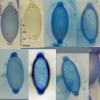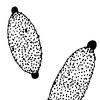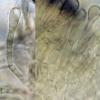
20-01-2026 17:49
 Hardware Tony
Hardware Tony
I offer this collection as a possibility only as e

15-01-2026 15:55
 Lothar Krieglsteiner
Lothar Krieglsteiner
this one is especially interesting for me because

17-01-2026 19:35
Arnold BüschlenHallo, ich suche zu Cosmospora aurantiicola Lite

16-01-2026 00:45
Ethan CrensonHi all, On decorticated hardwood from a New York

18-01-2026 12:24
Hello.An anamorph located on the surface of a thin

08-12-2025 17:37
 Lothar Krieglsteiner
Lothar Krieglsteiner
20.6.25, on branch of Abies infected and thickened
Thecotheus
Enrique Rubio,
01-06-2010 20:55
What's your opinion about this Thecotheus species that grows on cow dung. The spores are apiculate and reticulate, not only verrucose. Thecotheus lundqvistii seems to be close to our collection but there are any reference to the spore reticulation for this species in the keys (AAs, Doveri & Coué...).
Many thanks!
Enrique
Peter Welt,
01-06-2010 21:55

Re:Thecotheus
Hi Enrique,
If I have the spore dimensions, it should already be T. lundqvistii. The ornaments can change in age, well, as shown Benkert (ZfM 2010) also Trichophaea woolhopeia.
This species is not common. We have only one fund, also on cattle dung. T. holmskjoldii is much more common on dung from sheep.
Peter
If I have the spore dimensions, it should already be T. lundqvistii. The ornaments can change in age, well, as shown Benkert (ZfM 2010) also Trichophaea woolhopeia.
This species is not common. We have only one fund, also on cattle dung. T. holmskjoldii is much more common on dung from sheep.
Peter
Enrique Rubio,
01-06-2010 22:04
Re:Thecotheus
Hi Peter
Spore size fully agrees with T. lundqvistii (as my first photo says). Many thanks for your opinion.
Enrique
Spore size fully agrees with T. lundqvistii (as my first photo says). Many thanks for your opinion.
Enrique
Nicolas VAN VOOREN,
02-06-2010 07:45
Michel Delpont,
02-06-2010 14:00

Re:Thecotheus
Hi Enrique.
Usually the spores are finely warty T.lundqvistii uncrosslinked. Maybe you could also check if the paraphyses are hyaline.
Michel.
Usually the spores are finely warty T.lundqvistii uncrosslinked. Maybe you could also check if the paraphyses are hyaline.
Michel.
Enrique Rubio,
02-06-2010 14:56
Re:Thecotheus
The paraphyses are hyaline. Aas's original description says: 'ornamented with minute granules'.
Any mention of reticulate pattern...
My fungus fits well with lundqvistii except by the clearly reticulate ascospores!
By the other hand, hypermature ascospores can to lack apiculi (as lundqvistii), they turn very opaque, but still are reticulate, never verrucose. I feel is difficult to believe that this type of ornamentation can transform so much!
Enrique
Any mention of reticulate pattern...
My fungus fits well with lundqvistii except by the clearly reticulate ascospores!
By the other hand, hypermature ascospores can to lack apiculi (as lundqvistii), they turn very opaque, but still are reticulate, never verrucose. I feel is difficult to believe that this type of ornamentation can transform so much!
Enrique
Enrique Rubio,
02-06-2010 14:59
Re:Thecotheus
Nicolas. Have you tested your spore ornamentation with cotton blue?
Many thanks
Many thanks
Peter Welt,
02-06-2010 19:51

Re:Thecotheus
Hi Nicolas, Hi Enrique
You have so right, but similar observations can be in different genera, as do for example in Peziza. Should we just set up a new species? How many discoveries made by Aas T. lundqvistii? Zero and three species examined. If he could so capture the variation of this kind? I think not.
And so I findte it very well that such observations presented here we have a better understanding of the particular type.
Peter
You have so right, but similar observations can be in different genera, as do for example in Peziza. Should we just set up a new species? How many discoveries made by Aas T. lundqvistii? Zero and three species examined. If he could so capture the variation of this kind? I think not.
And so I findte it very well that such observations presented here we have a better understanding of the particular type.
Peter
Enrique Rubio,
02-06-2010 20:16
Re:Thecotheus
Thank you, Peter. Perhaps you are right.
Believe me. I do not chase to discover new species. Only I want to try to understand contradictory facts!
Enrique
Believe me. I do not chase to discover new species. Only I want to try to understand contradictory facts!
Enrique
Peter Welt,
02-06-2010 20:29

Re:Thecotheus
Hi Enrique,
No, I did not mean and not understood. Again, I think it's very good that you imagine your observations here. The only way we can expand our limited knowledge. Thank you
No, I did not mean and not understood. Again, I think it's very good that you imagine your observations here. The only way we can expand our limited knowledge. Thank you
Enrique Rubio,
02-06-2010 20:52
Re:Thecotheus
OK., Peter. Our limited knowledge...!
Thanks
Thanks
Nicolas VAN VOOREN,
03-06-2010 13:31

Re:Thecotheus
Enrique said "Have you tested your spore ornamentation with cotton blue?"
Yes, I do.
Yes, I do.
Enrique Rubio,
03-06-2010 16:39
Re:Thecotheus
Merci, Nicolas.
Enrique
Enrique
Enrique Rubio,
03-06-2010 20:46
Re:Thecotheus
Dear friends;
I have rehydrated an exsiccata of 2003, labeled as T. lundqvistii on cow dung, and I have observed a sub-reticulate pattern in the ascospores of one ascomata. Another fruitbody of the same collection shows me the typical finely verrucose pattern of this species.
I think Peter is right . Often we do not see the variability of the species!
Many thanks to all
Enrique
I have rehydrated an exsiccata of 2003, labeled as T. lundqvistii on cow dung, and I have observed a sub-reticulate pattern in the ascospores of one ascomata. Another fruitbody of the same collection shows me the typical finely verrucose pattern of this species.
I think Peter is right . Often we do not see the variability of the species!
Many thanks to all
Enrique
Ron Bronckers,
12-09-2010 15:25
Re:Thecotheus
Dear Enrique,
An interesting discovery that shows us not to underestimate the variability within the genus Thecotheus and Pezizales in general.
You also mention the absence of apiculi on hypermature ascospores in T. lundqvistii. Did you notice this phenomenon also in other species of Thecotheus?
With kind regards,
Ron
An interesting discovery that shows us not to underestimate the variability within the genus Thecotheus and Pezizales in general.
You also mention the absence of apiculi on hypermature ascospores in T. lundqvistii. Did you notice this phenomenon also in other species of Thecotheus?
With kind regards,
Ron
Enrique Rubio,
12-09-2010 18:25
Re:Thecotheus
Yes, Ron. At least, in T. rivicola I have observed this phenomenon too.
Enrique
Enrique
Ron Bronckers,
12-09-2010 21:43
Re:Thecotheus
Hi Enrique,
Thank you for your quick response.
Are you sure the ascospores in T. lundqvistii and T. rivicola were hypermature and not immature?
Can you remember if the ascospores of both species were ornamented at the time you observed the absence of the apiculi?
Kind regards,
Ron
Thank you for your quick response.
Are you sure the ascospores in T. lundqvistii and T. rivicola were hypermature and not immature?
Can you remember if the ascospores of both species were ornamented at the time you observed the absence of the apiculi?
Kind regards,
Ron
Enrique Rubio,
13-09-2010 19:20
Re:Thecotheus
I have observed some not apiculate and ornamented free ascospores out of the asci, but allways in a very small number.
Enrique
Enrique
Ron Bronckers,
14-09-2010 10:35
Re:Thecotheus
Thank you for the useful information.
Ron
Ron






